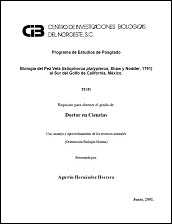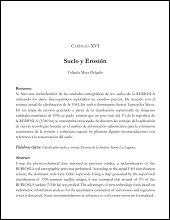Fauna de arañas del suelo de una comunidad árida-tropical en Baja California Sur, México
Resumen
"Se describe la temporalidad y diversidad de arañas del suelo del matorral sarcocaule en la región del Cabo en Baja California Sur. Durante 1991-1992 se realizaron colectas semanales por medio de trampas de caída. Se capturaron 4 322 ejemplares de 53 especies. Las familias con mayor abundancia fueron Miturgidae (42.2%), Oonopidae (23.5%), Caponiidae (8.0%) y Gnaphosidae (7.9%). Las especies más abundantes fueron Syspira tigrina Chamberlin (37.1%); Oonops nov. sp. (13.7%), Scaphiella hespera Chamberlin (7.8%) y Tarsonops sternalis Chamberlin (5.2%), que constituyeron el 63.7% del total de individuos. Gnaphosidae fue la más rica en especies (11), seguida por Salticidae (7). La riqueza de especies fue constante durante todo el año, con un ligero ascenso en el verano (29) y una ligera disminución en el invierno (24). La diversidad por estación del año se mantuvo en un intervalo de H’= 3.3 -3.7. La abundancia relativa se incrementó en primavera y otoño. La mayor riqueza específica se encontró en otoño. La abundancia relativa y la diversidad de arañas se pueden considerar altas, a pesar del fuerte dominio de la familia Miturgidae. En la mayoría de las especies, la distribución mostró una marcada estacionalidad. " "Seasonal distribution, specific richness, and diversity of xeric shrub ground spiders were studied at a site in the Cape Region. Weekly collections of spiders were made in 1991-1992 using pit-fall traps. We captured 4 322 specimens in 53 families. Families with the highest number of individuals were: Miturgidae (42%) Oonopidae (23.5%), Caponiidae (8.0%), and Gnaphosidae (7.9%). The most abundant species were Syspira tigrina Chamberlin (37.1%); Oonops nov. sp. (13.7%), Scaphiella hespera Chamberlin (7.8%), and Tarsonops sternalis Chamberlin (5.2%), representing 63.7% of the total specimens captured. Gnaphosidae was the richest in species (11) followed by Salticidae (7). Species richness was nearly constant during all the year, with a small increase in summer (29) and a small decline in winter (24); seasonal diversity was also constant (H’= 3.3-3.7). The highest relative abundance occurred in spring and autumn and the highest specific richness was in autumn. The diversity and relative abundance of spiders were high, in spite of the high abundance of Miturgidae. Distribution of the major species had a marked seasonality. "
Colecciones
Ítems relacionados
Mostrando ítems relacionados por Título, autor o materia.
-
PROMOCIÓN DEL PERIFITON PARA EL CULTIVO DE CAMARÓN BLANCO: HACIA UNA ACUICULTURA ECOLÓGICA
DOMENICO VOLTOLINA LOBINA; JUAN MANUEL AUDELO NARANJO; MARIA DEL ROSARIO PACHECO MARGES -
Suelo y Erosión
YOLANDA LOURDES MAYA DELGADO


